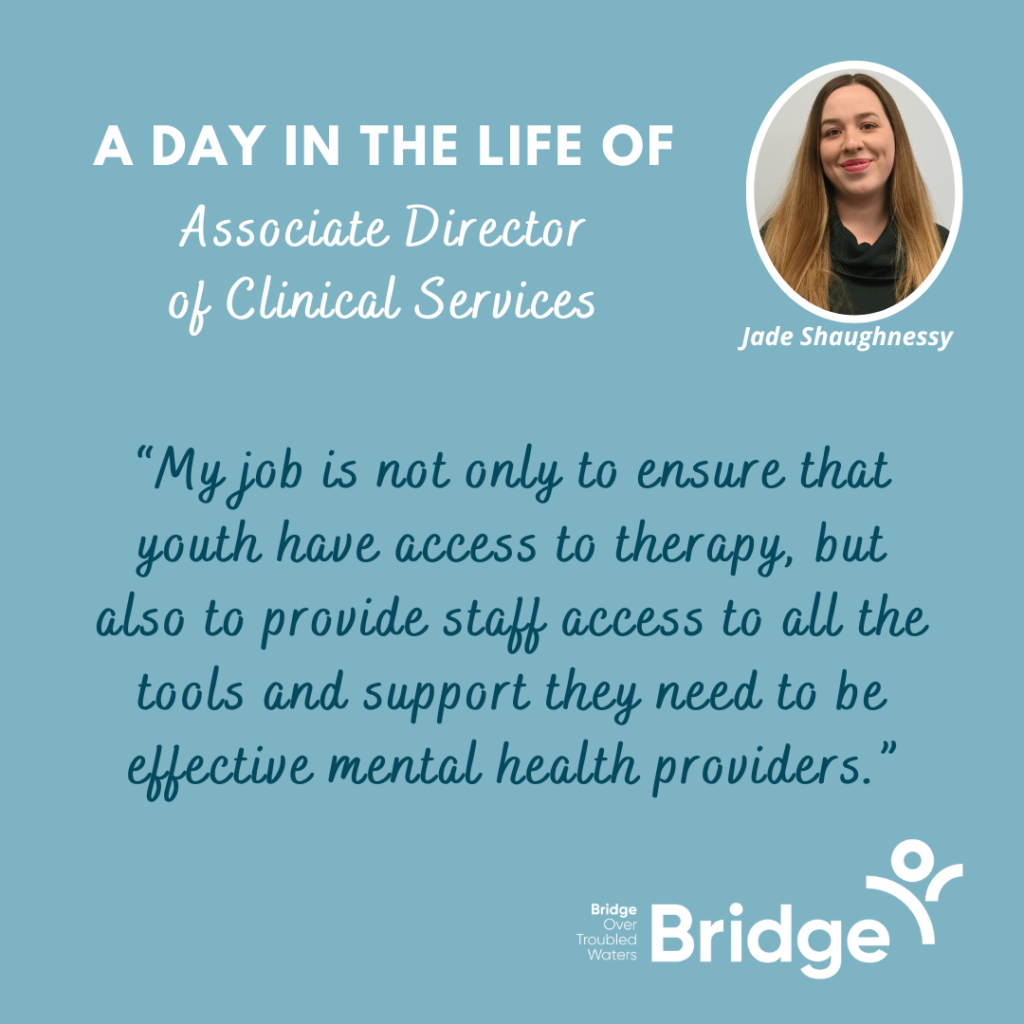A Day in the Life: Associate Director of Clinical Services Jade Shaughnessy
Spend a day with Associate Director of Clinical Services Jade Shaughnessy and learn how she helps youth develop the behavioral health skills and coping resources they need to succeed.
9 AM
I start the day by reviewing notes from yesterday’s clinician sessions. This allows me to catch up on what’s happening with different youth, note any progress or setbacks, and decide how to best guide my team of clinicians. A big part of my job involves leading supervision for the Behavioral Health team.
10 AM
I’m finishing up when there is a knock on my door. A Bridge Intake team member has walked a new youth to my office, and they appear anxious and upset. I welcome them and try to figure out what’s going on. I do a safety check and teach them a coping skill to handle stress. We set up an appointment with the counselor who I think will be the best fit for their ongoing care. Because they expressed interest, I also arrange for them to see one of our visiting psychiatrists from MGH.
11 AM
I meet with the Coordinator of the Emergency Residence program, who has noticed one youth self-isolating and seeming down. We discuss ideas for providing support, including Collaborative Problem Solving and reinforcing skills learned in therapy. Everyone involved in a youth’s care needs to be on the same page, so these cross-team meetings are vital.
12 AM

I head to the Transitional Day Program for lunch, where I get to spend time with the youth outside of therapy. This helps them feel more comfortable with me and see me as approachable, rather than an authority figure who sits in an office.
1 PM
I chat with a representative from the Department of Mental Health’s (DMH) Homeless Outreach Team. One youth, who has some mental health challenges, is aging out of our programs and needs a plan for next steps. I discuss options with the DMH representative, including residential facilities with clinical support, case manager assignments, group living situations, etc. I feel optimistic about the youth’s ability to live as independently as possible while still getting the help they need.
2 PM
I meet with my newest youth. In our first therapy appointment, it’s important to build rapport, hear the youth’s story in their own words, and learn how to help them achieve their goals. Afterward, I document what I’ve learned in a Comprehensive Assessment and develop a formulation to guide their treatment plan. In the next session, we will develop their therapy objectives. This collaboration helps make youth active participants in their mental health treatment.
3 PM
My team and I meet up to watch and discuss a video from our 16-month DBT (Dialectical Behavioral Therapy) training course. It teaches us how to lead DBT groups, how to help youth develop self-help skills (emotional regulation, stress reduction, crisis management, etc.), and how to train others to be coaches in these skills. These trainings are great, not only to help the counselors at Bridge develop their skills as clinicians, but also to provide tools we can share with all Bridge team members.
4 PM
Our Adolescent Counselor Ally updates me on a youth who has run away from home. This teen came to us adamant that they did not want to return to their family. Ally met with the family to understand their side of the story. Together, we discuss ways to bring the youth and their family back together, help them see each other’s perspectives, and provide them with resources, such as an in-home family counselor. We are confident that our plan will help us resolve the conflict and get the youth home safely. It’s a great feeling when we can reunite youth with their families and keep them from dangerous situations, like being on the streets.
5 PM
I jot down some notes on the family counseling situation before packing up my things and heading out for the day.